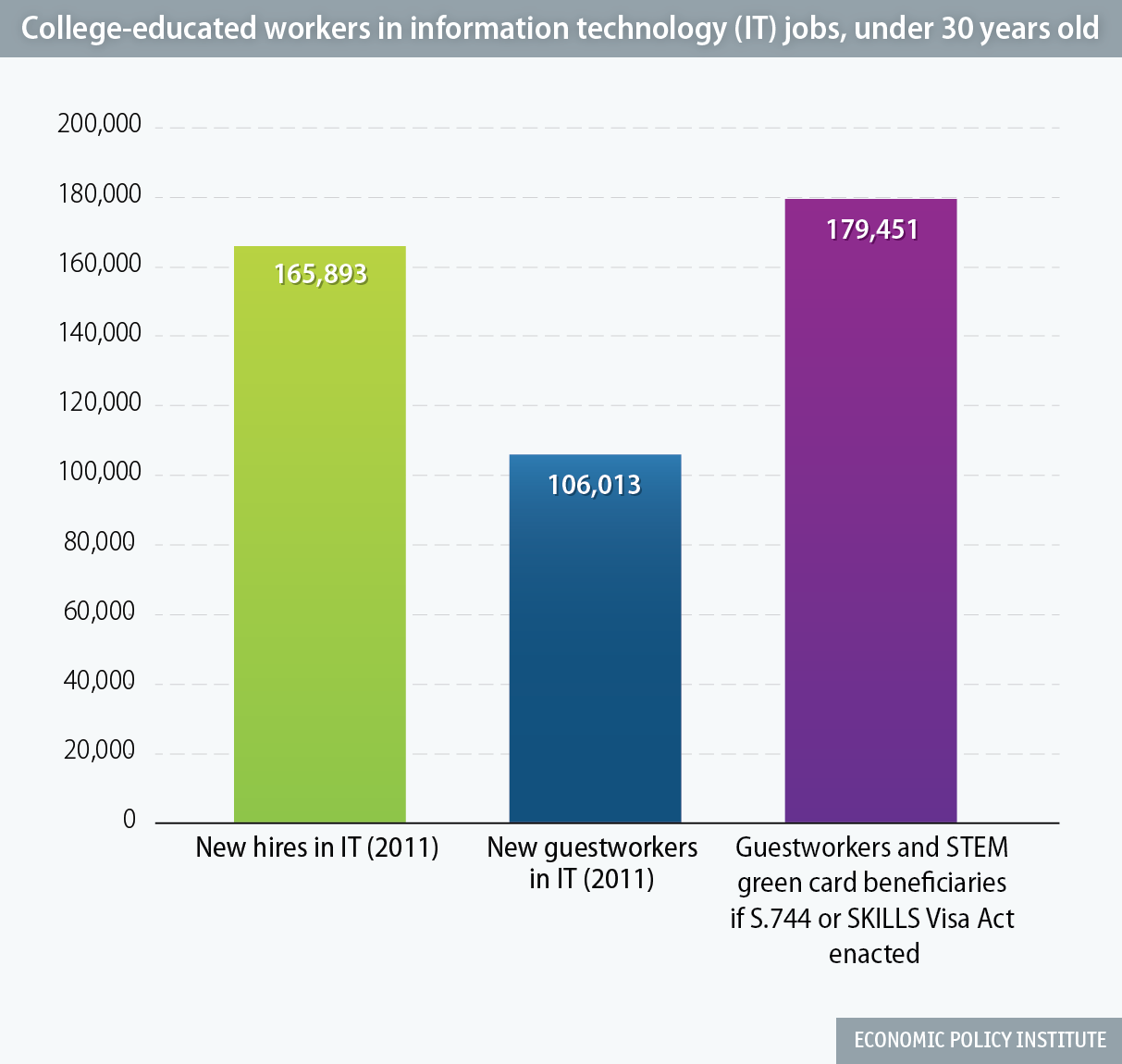In 2011, the number of high-skilled (i.e., possessing at least a college degree) guestworkers was estimated to be equal to between one-third to one-half of new job openings filled by all college graduates in the information technology (IT) sector. However, a new analysis finds that in 2011, the number of college-educated guestworkers under the age of 30 in IT was equal to two-thirds of all the 166,000 new college-educated IT job holders under the age of 30. At a time when Congress is proposing to dramatically increase the number of skilled guestworkers available to IT and other industries, it is important to consider the adverse impact of increasing the guestworker flow on U.S. college graduates just entering the workforce and on those in school making plans for their future.
According to the U.S. Government Accountability Office, the country’s largest skilled guestworker program (H-1B) is primarily used to fill “entry-level” positions. Thus, recent graduates in the science, technology, engineering and math (STEM) fields seeking an initial foothold in the IT job market are competing directly with young college-educated guestworkers for these entry-level positions. The large supply of young guestworkers not only provides competition to new U.S. graduates, but also provides a large supply of younger, lower-paid workers who can substitute for older workers. The effect of this large supply of guestworkers can be seen in wages in IT, which have remained flat, and are hovering around late 1990s levels in real terms. This lack of wage growth acts as a discouraging signal to STEM grads considering entering the IT job market.
If we more than double the supply of H-1B guestworkers and create a new green card category for foreign-born STEM graduates—as both chambers of Congress have recently proposed—it will have a significant negative impact on both the long-term strength of the U.S. STEM workforce and the employment prospects for those just entering college. Already U.S. colleges graduate 50 percent more computer science majors than are able to find a job in IT. If either the proposed SKILLS Visa Act from Representatives Issa (R-Calif.) and Goodlatte (R-Va.), or the current version of the proposed comprehensive immigration reform bill in the Senate is enacted (S.744), a conservative estimate is that there will be 180,000 new college-educated IT workers under 30 years old entering the labor market every year via guestworker visas or STEM green cards. If this occurs, each year the number of new IT guestworkers and STEM green card beneficiaries will be greater than the number of new hires of young IT college graduates in 2011. Such a policy will discourage U.S. students with STEM degrees from entering IT, the country’s largest high-tech field, comprising half of the entire STEM workforce.

Note: For explanation and detailed estimates of IT guestworker population, see Salzman, Kuehn and Lowell, Guestworkers in the High-Skill Labor Market (esp. Figure G and Table 2), http://www.epi.org/publication/bp359-guestworkers-high-skill-labor-market-analysis/. For L visa holders, authors assume the same age distribution as all H-1B workers as reported by Department of Homeland Security (DHS) in the 2012 Characteristics of H-1B Specialty Occupation Workers report, and assume 90 percent of workers in the Optional Practical Training (OPT) program are under age 30. For STEM green card estimates, authors assume the same percentage enter the IT workforce as those on the OPT-STEM extension (77%) and that 90 percent are under the age of 30 (because they are recent graduates). Share of new IT workers derived from the projected annual flow under S.744 and SKILLS Visa Act utilize the lower H-1B and STEM green card quotas set under the SKILLS Visa Act.
Source: Nonimmigrant Visa Statistics website, Department of State, http://travel.state.gov/visa/statistics/nivstats/nivstats_4582.html; Characteristics of H-1B Specialty Occupation Workers, DHS, http://www.uscis.gov/USCIS/Resources/Reports%20and%20Studies/H-1B/h1b-fy-11-characteristics.pdf; unpublished DHS data (for OPT); and Current Population Survey Job Tenure Supplements microdata, various years (survey conducted by the Bureau of the Census for the Bureau of Labor Statistics [machine-readable microdata file]), U.S. Census Bureau. Proposed legislation: SKILLS Visa Act, http://issa.house.gov/skills/; and Senate Bill 744 (2013), as amended, http://www.judiciary.senate.gov/legislation/immigration/MDM13735.pdf (last visited May 28, 2013).
